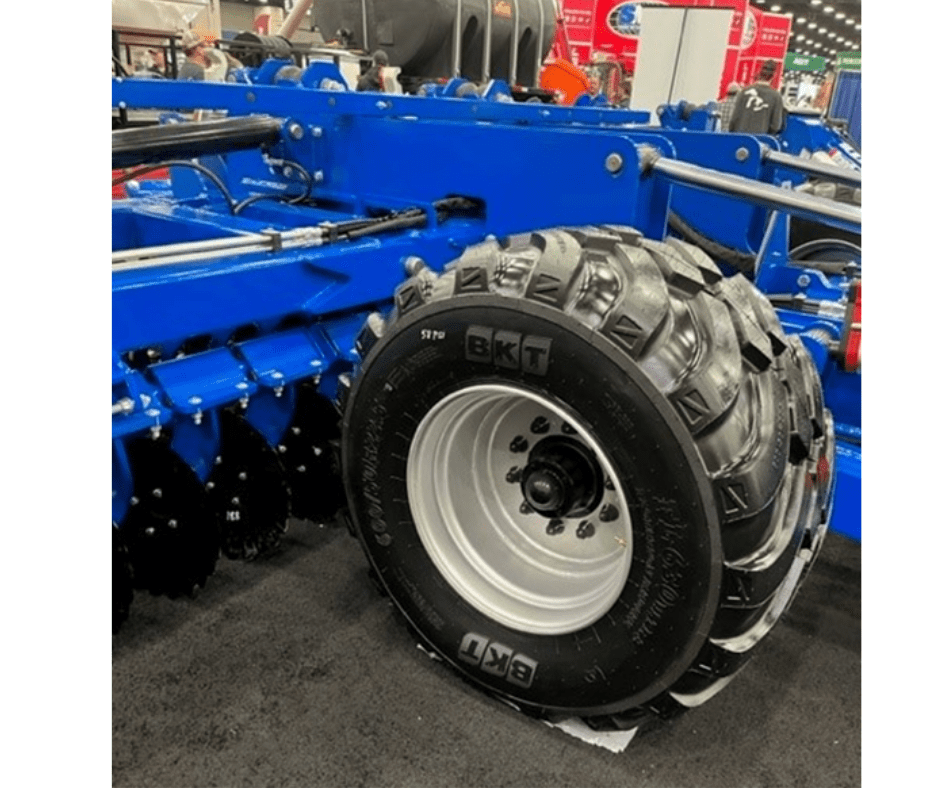AG TIRE TALK KEY TAKEAWAYS
BKT: “With heavier equipment and road use more prevalent, small implement tires are now being designed using radial technology to carry heavier weights at highway speeds (30-45 mph).”
MAXAM: “As more farmers or growers adopt radial solutions, we may as well see the market shift towards more tractive designs closer to the I-2 or I-3 tread types.”
FIRESTONE: “Implement tires are pivoting from smaller (15” and 16”) to larger sizes (22.5”, 26.5” and 30.5”) because they have larger air chambers that enable them to carry more load or the same load at a lower inflation pressure.”
MICHELIN: “Directional Implement Tire Tread Designs help the tire to remain cool and slows the rate of wear by, both, creating flex and limiting flex in very specific areas of the rubber.”
TRELLEBORG: “Steel belts are used under the tread as part of the casing. This strengthens the casing to last longer and also flatten the tread face and make a wider footprint. This helps with tire wear and vehicle stability.”
Michelin Ag
David Graden: Global Account Manager – Agriculture
Increasing Tire Demands
Large farms are getting bigger and the number of people pursuing farming as an occupation is declining. In turn, the need to cover more land with fewer people, resources and time is driving the demand for larger machines and implements.
As a result of growing farm sizes, producers are finding it necessary to spend more time on the road between plots of land. Extended roading can cause heat to build up, creating breakdown of rubber compounds that can ultimately lead to a shorter tire life span.
Directional Tread Designs
To help alleviate this issue, tire manufacturers are designing implement tires with directional tread designs. This helps the tire to remain cool and slows the rate of wear by, both, creating flex and limiting flex in very specific areas of the rubber. As an added bonus, engineered tread designs also add stability on slopes and stubble protection where it is needed most. Additionally, most tire manufacturers make tires for global needs. In most European countries, a producer is required by law to remove any soil or mud their machines release onto the road. For that reason, Michelin prides itself on designing tire treads to clean out mud quickly. Not only does this reduce the amount of road shoveling a producer is required to do, but it also significantly improves tractive capacity for those tires in powered positions.
Michelin TrailXBib
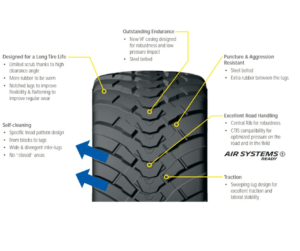
Larger Sizes
One of the greatest challenges in the tire industry is machinery size. As machinery gets larger so does the need for tires that can carry the weight of those machines. From a tire perspective, the air chamber is what carries that weight and the rubber doughnut around it simply holds the air in place. The heavier the weight, the larger the air chamber and tire needs to be.
IF/VF Technology
In the early 2000’s, Michelin invented IF and VF technology. The purpose behind this was to increase carrying capacity without changing the tire size, due to limited space tires have to fit under machines. We did this by simply changing the flex point in the sidewall of that tire, which reduced the pounds per square inch on the tread and relieved the stress points on that rubber doughnut holding air in place.
Today VF type tires are becoming the standard. In fact, machinery size is growing so fast, larger tire sizes are need in conjunction with VF technology simply to carry the weight demanded by these large machines.
BF Goodrich Implement Control
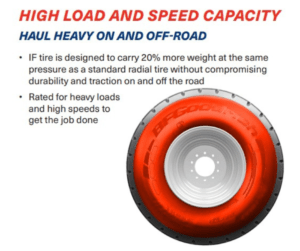
Go Large & IF/VF
On a final note, as these large machines get larger, the yield damaging soil compaction is almost inevitable. For this reason, it is imperative to fit your machines with the largest VF tires allowable. Harper Adams University, in the UK, and University of Illinois Champaign Urbana have both proven Michelin VF tires set to the proper air pressure recommendations will reduce soil compaction and result in up to 4.3% improvement in yield of soybeans, corn and wheat. I am sure this additional yield will apply to other crops as well, but those studies have not been done yet.
For these reasons, tire technology will have to continue to evolve as machinery and farming evolves. The tires under your machine are the only thing standing between a properly operating machine and complete efficiency and performance.
BKT USA, Inc.
David Paulk: Manager Field Technical Services
Implement tire designs and sizes continue to evolve and grow with the use of heavier equipment and wagons. The smaller 15” and 16” tires in a bias design have been used for a long time. Since there are still many implements that use these sizes, they aren’t going away anytime soon. The 15” and 16” sizes are still used in large numbers in bias tires.
With heavier equipment and road use more prevalent, small implement tires are now being designed using radial technology to carry heavier weights at highway speeds (30-45 mph). Many are made with steel belts and stubble resistant compounds to help maintain the integrity of the tire and provide added puncture resistance in the field and on the road. Some are IF and VF rated and can be run at lower air pressures in the field to minimize soil compaction. BKT’s 19.5” and 22.5” I-1 radials are made with an all-steel construction. The 15” to 22.5” radial sizes are used on cultivators, planters/seeders, and a wide array of other equipment.
Although smaller implement tires are still widely used, larger implement tires (flotation tires) have become more common because of the weight of the equipment and wagons and the load carrying capacities needed. The larger sizes include 22.5”, 26.5”, and 30.5” with a few sizes of 32” available. These are used on larger implements such as planters and on liquid and dry manure spreaders in dairy and feedlot operations. Some flotation sizes are used on larger hay balers. These tires are taller and wider to carry high loads on the highway at higher speeds. The wider width gives the tires good flotation when used in the fields and can spread out the weight of the load to minimize soil compaction.
800/45R26.5 BKT FL630 Ultra

While most of the smaller implement tires, bias and radial, are made in an I-1 design (rib type tire), the I-2 and I-3 designs (traction treads) have gained popularity in the larger implement (flotation) sizes. As opposed to the I-1 design, this tire provides some traction in the field if needed. When used in wet soil and on hills, the traction design limits the side to side (lateral) movement. With the correct air pressures, the tires generally wear well in highway use. Most are used in pull behind the tractor operations, although there are some self-propelled applications.
600/50R22.5 BKT FL630 Ultra
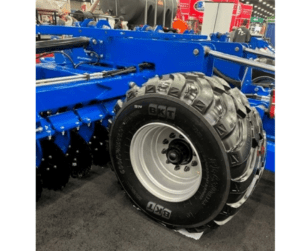
More of the larger implement radial sizes are steel belted or made with all steel construction. Both are used to maintain the integrity of the tire while in use. Both also add puncture resistance to minimize downtime and damage to the casing. The all-steel casings increase load carrying capacity as most are VF rated. VF technology and all steel casings are becoming more available because of the weight carrying capacity and speeds needed for applications using these tires. BKT makes both steel belted and all steel radials in certain sizes.
VF900/65R32 BKT FL690
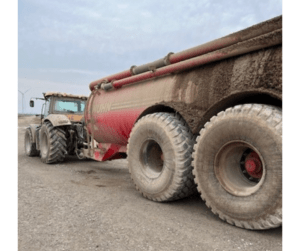
Maxam Tire North America Inc.
Greg W. Gilland: Vice President, Global Agriculture
The agricultural tire industry is in a constant flux of change that is evolving the boundaries of tire technology to achieve greater productivity and performance. Today’s farmers and growers are demanding improved tire solutions to increase their crop yields, reduce soil compaction, and achieve better value to increase their profits. Over the last 20 years, we have seen the agricultural market move from bias ply tires to radial tire technology which has been accelerating year over year, particularly in the +100 HP type machinery including tractors, floaters, sprayers, and combine harvesters.
Due to the perceived acquisition price difference, we still see a large percentage of smaller tractors below 100 HP primarily using bias ply tires versus adopting the growing radial product offer that delivers improved performance and value. Year over year, it is evident that increasing crop yields remain the number one priority for any farming operation, especially when using equipment above 100 HP. This increased demand for greater productivity has driven a rapid change towards adopting radial tire solutions beyond heavy equipment (above 100 HP) to their support equipment or implements in search of improved solutions that can lower their current high tire inflation pressures required to carry the respective loads. This market evolution has fueled the movement to adopt radial tire technology despite a higher acquisition price versus current bias ply tires. The platforms associated with this evolving trend include cultivators, diskers, rippers, planters and more primarily using smaller implement tires from 14” up to 18”. The growing use of radial tires on both towed implements and tractors provides greater traction in the field, which is achieving improved productivity, fuel savings, and more importantly generating larger crop yields through reduced soil compaction.
When comparing the various types of Implement tires in the agricultural industry we find that each tread design has unique features depending on their function, tread depth, and soil working conditions. In the North American market, we see the following tire types or demand for implement tires:

The primary market sizes that account for the largest volumes of implement tires are the following three sizes primarily concentrated in the I-1 Rib Tread pattern:

The demand for greater productivity has rapidly driven a transition from the above bias sizes to equivalent radial tire solutions that have incorporated the use of both IF and VF tire technology. This technology shift is allowing new radial implement tires to carry 20% to 40% more weight at standard inflation pressures or the ability to reduce soil compaction by reducing the inflation pressure between -20% up to -40% by elongating the tread footprint thus increasing the flotation capability of the tires for each given load. In most instances, we are seeing the new radial tires being used at standard inflation pressures to carry the heavier loads now on newer larger implements allowing farmers or growers to achieve improved productivity without compromising soil conditions. The above three bias ply implement sizes have been converted to the following radial tire sizes:

In most cases, as the above radial sizes continue to evolve and adopt either IF or VF technology, we expect to see the utilization of both steel belts and steel casings to enhance the footprint and stabilize the heavier loads on the road or in the field. The row crop applications in North America seem to dominate the primary and largest part of the implement tire market which overwhelmingly prefers the I-1 tread design over the more traction-oriented I-2 or I-3 tread designs. Currently, the radial portion of the implement market only represents about 10% of the North American total implement tire demand, however, that number continues to grow rapidly year over year as more farmers or growers adopt radial solutions that may as well see the market shift towards more tractive designs closer to the I-2 or I-3 tread types. MAXAM Tire currently offers the below bias ply products to meet the implement tire market needs:

As the implement tire market continues to evolve from bias tires, MAXAM will bring radial solutions to the market to deliver performance-driven products that will meet or exceed our customer’s value expectations.
In addition to the evolution of bias ply implement tires to radial solutions, we are also seeing a migration from bias ply flotation sizes to radial flotation sizes in the larger diameter 22.5,” 26.5”, and 30.5” rim seats to meet the heavier towed tanker or cargo hauler applications. This evolution is happening at a faster rate each year as European-type towed machinery continues to drive global changes toward these high-load / high-speed platforms. The largest shift in technology is the move from bias ply tires to radial steel belted or fully steel constructed I-3 flotation tires that deliver improved traction using both closed and open shoulder designs that address the various soil condition challenges across the global market. In addition, we are seeing a demand for new radial tires that have heavier load-carrying capabilities with D-rated heat-dissipating rubber compounds capable of speeds up to 40 mph (65 kph). The transition to D-rated tires is being driven by the faster road speed required to move the equipment from the farm to the field or to the market to meet the growing population demand.
As tractors continue to grow in horsepower, we fully expect the radial flotation tire sizes to evolve as well using VF technology to increase load-carrying capacity and corresponding speed capability to support the heavier or more powerful machinery. MAXAM offers the current FlotXtra full steel construction tire with a closed shoulder non-directional design to meet the heaviest load application. The new directional steel belted AgilXtra features an open shoulder and improved self-cleaning tread design. Both the FlotXtra and AgilXtra deliver the high load and D-rated speeds the market is seeking in towed flotation solutions:
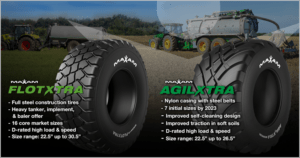
MAXAM agricultural tires are designed to deliver an optimized footprint ensuring the best possible traction and flotation for any application. Our families of both radial and bias ply implement tires are engineered to perform and ensure that at the right air pressure for the given load, our tires will provide the value our customers expect from MAXAM.
Trelleborg Wheel Systems
Chris Neidert: Marketing, Training and Development Manager – AG
The implement tires today are not what your father used in the past. Implements have been evolving into larger sizes, heavier equipment and higher working speeds but still confined to be as small as possible. These challenges require the tires to also evolve and shift from traditional bias low speed construction to high speed, high load capacity, radial construction tires.
To maximize crop yields and transport times, it is necessary to invest in high performance machinery. With new technologically advanced implement tires, you can increase the load capacity of your equipment, such as manure tankers, big forage wagons and slurry tankers while protecting the environment.
You need tires that will ensure long durability and superior performance both in the field and on the road. In the field, the tire needs to have excellent flotation and self-cleaning features. On the road, it must deliver a comfortable ride and easy handling while providing increased stability and overall drivability.
This increase in load capacity requires stronger tire construction and a stronger bond between the tire and the rim. Most of these tires require an increase angle of the bead seating area from 5 to 15 degree to withstand these additional pressures and efforts. Tires and rims designed with a bead angle of 15 degree can be identified as the rim diameter value ends in .5 (for example a 560/60R22.5) and designated as IMP.

Steel belts are used under the tread as part of the casing. This strengthens the casing to last longer and also flatten the tread face and make a wider footprint. This helps with tire wear and vehicle stability. The wider footprint increases flotation and reduces compaction, protects the soil and improves crop yield.
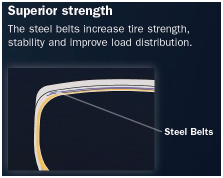
Let’s talk about the tread.
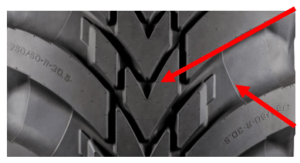
Many implement tires are being produced with different tread patterns. The goal is to enhance tread stability which translates to vehicle stability when the vehicle is fully loaded. Some patterns could be called directional, which will help channel water out from under the tread.
In order to keep road debris to a minimum, various methods are used to keep the tread from loading up with mud. Reducing the amount of mud in the tread will translate to less road debris when the machine pulls out of the field and on to the road to go to the next field. Terraces in the bottom of the tread grooves help reduce mud build-up.
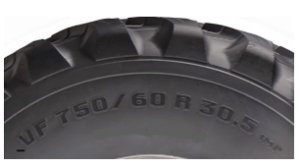
The latest technology development in implement tires is the offering of VF technology complementing the “conventional” radial construction. VF construction tires are designed to increase the load capacity at high speed, improving overall efficiency of the tire and implement. In field application it can be used at lower inflation pressure, delivering a wider and longer footprint and therefore reducing ground pressure and maximizing crop yield.
VF stands for Very High Flexion radial tire. Main advantage of this type of construction is to allows the tire to carry up to 40% more load than a tire “conventional” radial tire at the same air pressure and nominal speed.

As you can see in Figure A, both tires are the same size and running at the same air pressure. The tire on the left has VF technology construction and is able to carry approximately 40% more load than a “conventional” non-VF tire. Able to carry more weight will mean fewer trips, saving costs. If you are a manure tanker operator, this is a huge benefit.
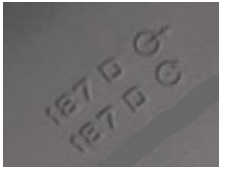
These new generation of implement tires are now being built with higher load indexes than in past years. Our picture to the left shows implement tire sidewall with its Load Index marking and its Speed Symbol.
Referring to a Load Table, the 187 equates 21,500 lbs. of carrying capacity at nominal inflation pressure and nominal speed. Far higher than in years past.
Implement tires are now being asked to not only carry more weight, but to do it at a higher speed. Our picture to the left shows a Speed Symbol of D. This equates to the tire being able to sustain a high speed of 40 miles per hour.
I think you will agree, the tire world has reacted to needing to be bigger and faster. The new implement tires are not your father’s implement tires.
Firestone Ag
Austin Fischer: Firestone Ag Field Engineer
Pivoting from Smaller to Larger Diameters and Section Widths
Implement tires are pivoting from smaller (15” and 16”) to larger sizes (22.5”, 26.5” and 30.5”) because they have larger air chambers that enable them to carry more load or the same load at a lower inflation pressure. Additional advantages include increased ground clearance and greater flexibility for OEs to install hardware like central tire inflation or braking systems within the envelope of the rim.
Trending toward Higher Void Ratio Directional Tread Designs
Another trend we’re seeing is increased interest in higher void ratio directional tread designs (I-2/I-3) compared to I-1 designs. These I-2/I-3 designs offer enhanced performance in wetter and/or softer soils, and their deeper tread depth can help extend tire life.
VF Construction & Steel Belt/All-Steel Casings
Regarding trends toward all-steel construction, this will depend on the size of the tire and the load it is required to carry. Implementing an all-steel construction has its benefits, but it also presents unique challenges in manufacturing and in the field, especially when growers are operating at lower inflations.
Going forward, we may not see much room in the market for non-VF tires in smaller sizes, but we do anticipate standard options to remain available in the larger sizes for the foreseeable future.
To note: all Firestone radial implement tires are steel-belted, while those with a rim diameter greater than 15” are also steel-bodied for an all-steel construction.
All information is provided in this blog solely to provoke thought. All deductions made from information on this site must be confirmed by Certified Ag Tire Dealer before use. Ag Tire Talk does not recommend anyone conduct tire service work with exception of Certified Ag Tire Dealer Professionals.

